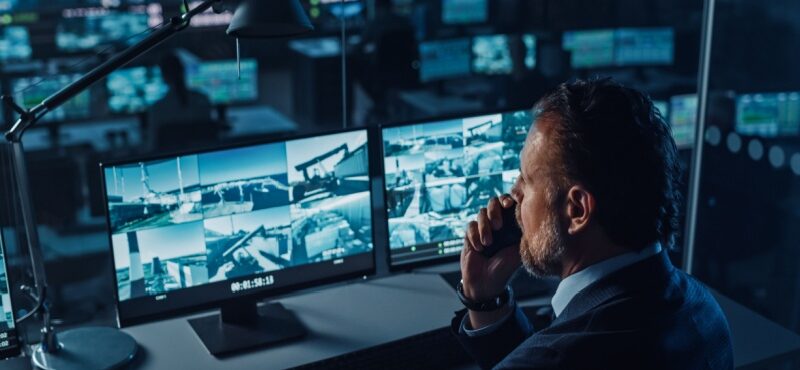Ports play a critical role in global trade, serving as entry points for goods and people. With the increasing scale of maritime operations, ensuring the security of port facilities and vessels has become more complex and essential. Incidents such as cargo theft, unauthorized access, and potential terrorist threats highlight the need for advanced security measures in these areas. Video surveillance is one of the most effective tools for enhancing port security and vessel safety, helping to deter criminal activity, monitor operations, and improve emergency response.
Enhancing Port Security with Video Surveillance
Deterring Unauthorized Access and Criminal Activities: Ports are high-traffic areas that can be vulnerable to theft, vandalism, and unauthorized access. Strategically placed surveillance cameras deter potential criminals by increasing the risk of being caught. Visible cameras around port entrances, restricted zones, and cargo areas signal that activities are being monitored, which discourages unlawful behavior. Surveillance also enables security personnel to monitor access points and detect suspicious behavior before incidents occur.
Monitoring Cargo Handling and Logistics: Ports handle enormous volumes of cargo, making efficient operations a priority. Video surveillance allows port authorities to monitor loading, unloading, and handling processes in real time. This oversight helps ensure that cargo is managed according to protocols, reducing the risk of damage, contamination, or misplacement. Monitoring logistics also helps identify bottlenecks and inefficiencies, improving the overall productivity of port operations.
Supporting Emergency Response: When incidents or emergencies arise, quick response is essential. Video surveillance systems provide real-time visual data, allowing security teams to assess the situation quickly and accurately. For instance, if a fire breaks out, cameras can help determine the source of the fire, identify potential hazards, and guide emergency responders to the exact location. In addition, footage can be shared with local law enforcement, coast guard, or other emergency services, enhancing coordination and response times.
Compliance with Regulatory Standards: Ports must adhere to various security regulations and industry standards, such as the International Ship and Port Facility Security (ISPS) Code. Video surveillance is a valuable tool for demonstrating compliance with these standards, as it provides a documented record of security measures and incident responses. Regular monitoring and recording of activities ensure that ports maintain a high level of security and can provide evidence to regulatory authorities as required.
Improving Vessel Safety through Surveillance
Preventing Onboard Theft and Security Breaches: Vessels, especially large cargo ships, face the risk of onboard theft, stowaways, and other security breaches. Surveillance cameras installed on vessels help monitor sensitive areas, such as cargo holds, engine rooms, and restricted access zones. By keeping an eye on these areas, crew members can quickly identify unauthorized access or suspicious behavior, reducing the risk of theft or other security threats.
Monitoring Crew Safety and Compliance: Video surveillance enhances crew safety by allowing officers to monitor activities on board and ensure that all safety protocols are being followed. In environments such as the engine room or on the deck, where accidents are more likely to occur, cameras can help detect unsafe practices and enforce compliance with safety regulations. In the event of an accident, video footage can also provide valuable insights into the cause, helping to prevent future incidents.
Assisting in Navigation and Collision Avoidance: Surveillance cameras are useful for navigation, particularly when vessels are docking, undocking, or maneuvering in tight spaces. Cameras positioned around the exterior of the vessel provide a wider view, allowing the crew to see blind spots and avoid potential collisions. This is especially important for large vessels that may have limited visibility, and for vessels operating in congested or narrow waterways. Video feeds from these cameras can also be integrated into bridge displays, providing captains and navigational officers with a comprehensive view of the vessel’s surroundings.
Advancements in Video Surveillance Technology
Modern video surveillance systems allow for remote access, enabling port authorities and vessel crews to monitor activities from any location. This capability is particularly valuable for port management, as it allows security teams to maintain oversight of multiple locations simultaneously. Remote access also enables centralized monitoring, where surveillance footage from multiple sites can be viewed and managed from a single control center, improving operational efficiency.
AI-driven video surveillance is a growing trend in port and maritime security. AI can automatically detect unusual behavior, such as unauthorized entry, loitering, or movements in restricted areas. These intelligent systems can alert security personnel in real time, allowing for proactive responses to potential security threats. In addition, AI can help analyze large volumes of footage more efficiently, identifying patterns and trends that might otherwise go unnoticed.
High-definition (HD) cameras with low-light and infrared capabilities are particularly beneficial in maritime environments, where poor visibility and nighttime operations are common. These cameras provide clear images in challenging lighting conditions, ensuring that security personnel can monitor activities around the clock. Enhanced image quality also allows for better identification of individuals and details, such as license plates or vessel identification numbers, which is valuable for both security and compliance purposes.
Video Surveillance as a Maritime Security Solution
As the maritime industry continues to grow, so too does the need for robust security measures in ports and on vessels. Video surveillance offers a versatile, effective solution that enhances port security, ensures compliance, and improves the safety of crew members and assets. By investing in advanced surveillance systems, ports and vessels can create a safer, more secure environment that is better equipped to handle the challenges of modern maritime operations.
For businesses looking to enhance their security infrastructure, Highland Wireless offers comprehensive video surveillance solutions designed to meet the unique needs of ports and vessels. Contact Highland Wireless now to learn more about how our surveillance technology can improve safety and security in your maritime operations.

